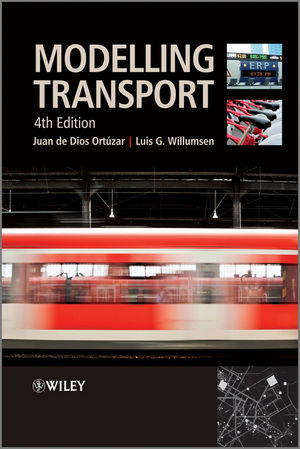|
Textbook
Modelling Transport, 4th EditionISBN: 978-0-470-76039-0
Hardcover
608 pages
April 2011, ©2011
 This is a Print-on-Demand title. It will be printed specifically to fill your order. Please allow an additional 15-20 days delivery time. The book is not returnable.
|
||||||
Preface.
1 Introduction.
1.1 Transport Planning and Modelling.
1.2 Characteristics of Transport Problems.
1.3 Modelling and Decision Making.
1.4 Issues in Transport Modelling.
1.5 The Structure of the Classic Transport Model.
1.6 Continuous Transport Planning.
1.7 Theoretical Basis Versus Expedience.
2 Mathematical Prerequisites.
2.1 Introduction.
2.2 Algebra and Functions.
2.3 Matrix Algebra.
2.4 Elements of Calculus.
2.5 Elementary Mathematical Statistics.
3 Data and Space.
3.1 Basic Sampling Theory.
3.2 Errors in Modelling and Forecasting.
3.3 Basic Data-Collection Methods.
3.4 Stated Preference Surveys.
3.5 Network and Zoning Systems.
Exercises.
4 Trip Generation Modelling.
4.1 Introduction.
4.2 Regression Analysis.
4.3 Cross-Classification or Category Analysis.
4.4 Trip Generation and Accessibility.
4.5 The Frequency Choice Logit Model.
4.6 Forecasting Variables in Trip Generation Analysis.
4.7 Stability and Updating of Trip Generation Parameters.
Exercises.
5 Trip Distribution Modelling.
5.1 Definitions and Notation.
5.2 Growth-Factor Methods.
5.3 Synthetic or Gravity Models.
5.4 The Entropy-Maximising Approach.
5.5 Calibration of Gravity Models.
5.6 The Tri-proportional Approach.
5.7 Other Synthetic Models.
5.8 Practical Considerations.
Exercises.
6 Modal Split and Direct Demand Models.
6.1 Introduction.
6.2 Factors Influencing the Choice of Mode.
6.3 Trip-end Modal-split Models.
6.4 Trip Interchange Heuristics Modal-split Models.
6.5 Synthetic Models.
6.6 Direct Demand Models.
Exercises.
7 Discrete Choice Models.
7.1 General Considerations.
7.2 Theoretical Framework.
7.3 The Multinomial Logit Model (MNL).
7.4 The Nested Logit Model (NL).
7.5 The Multinomial Probit Model.
7.6 The Mixed Logit Model.
7.7 Other Choice Models and Paradigms
8 Specification and Estimation of Discrete Choice Models.
8.1 Introduction.
8.2 Choice-Set Determination.
8.3 Specification and Functional Form.
8.4 Statistical Estimation.
8.5 Estimating the Multinomial Probit Model.
8.6 Estimating the Mixed Logit Model.
8.7 Modelling with Stated-Preference Data.
Exercises.
9 Model Aggregation and Transferability.
9.1 Introduction.
9.2 Aggregation Bias and Forecasting.
9.3 Confidence Intervals for Predictions.
9.4 Aggregation Methods.
9.5 Model Updating or Transferance.
Exercises.
10 Assignment.
10.1 Basic Concepts.
10.2 Traffic Assignment Methods.
10.3 All-or-nothing Assignment.
10.4 Stochastic Methods.
10.5 Congested Assignment.
10.6 Public-Transport Assignment.
10.7 Limitations of the Classic Methods.
10.8 Practical Considerations.
Exercises.
11 Equilibrium and Dynamic Assignment.
11.1 Introduction.
11.2 Equilibrium.
11.3 Transport System Equilibrium.
11.4 Traffic Dynamics.
11.5 Departure Time Choice and Assignment.
Exercises.
12 Simplified Transport Demand Models.
12.1 Introduction.
12.2 Sketch Planning Methods.
12.3 Incremental Demand Models.
12.4 Model Estimation from Traffic Counts.
12.5 Marginal and Corridor Models.
12.6 Gaming Simulation.
Exercises.
13 Freight Demand Models.
13.1 Importance.
13.2 Factors Affecting Goods Movements.
13.3 Pricing Freight Services.
13.4 Data Collection for Freight Studies.
13.5 Aggregate Freight Demand Modelling.
13.6 Disaggregate Approaches.
13.7 Some Practical Issues.
14 Activity Based Models.
14.1 Introduction.
14.2 Activities, Tours and Trips.
14.3 Tours, Individuals and Representative Individuals.
14.4 The ABM System.
14.5 Population Synthesis.
14.6 Monte Carlo and Probabilistic Processes.
14.7 Structuring Activities and Tours.
14.8 Solving ABM.
14.9 Refining Activity or Tour Based Models.
14.10 Extending Random Utility Approaches.
15 Key Parameters, Planning Variables and Value Functions.
15.1 Forecasting Planning Variables.
15.2 Land-Use Transport Interaction Modelling.
15.3 Car-Ownership Forecasting.
15.4 The Value of Travel Time.
15.5 Valuing External Effects of Transport.
Exercises.
16 Pricing and Revenue.
16.1 Pricing, Revenue and Forecasting.
16.2 Private Sector Projects.
16.3 Risk.
16.4 Demand Modelling.
16.5 Risk Analysis.
16.6 Concluding Remarks.
References.
Index.



